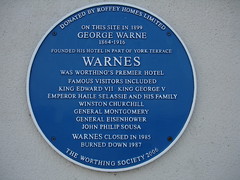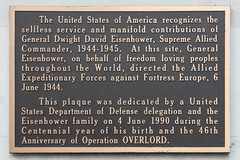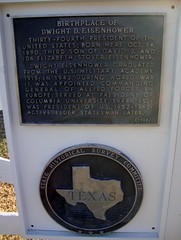General Dwight D. Eisenhower OM


General Dwight D. Eisenhower OM
(1890-1969)
United States Army General, Commander-in-Chief Allied Force (1942), Supreme Commander Allied Expeditionary Force (1944), Order of Merit recipient (from 1945), and 34th President of the United States (1953-1961)
Family tree
Commemorated on 13 plaques
On this site in 1899 George Warne 1864-1916 founded this hotel in part of York Terrace Warnes was Worthing's premier hotel famous visitors included King Edward VII King George V Emperor Haile Selassie and his family Winston Churchill General Montgomery General Eisenhower John Philip Sousa Warnes closed in 1985 burned down 1987
Marine Parade, Worthing, United Kingdom where they visited
In this building were located the headquarters of General of the Army Dwight D. Eisenhower Commander in Chief Allied Force June-November 1942 Supreme Commander Allied Expeditionary Force January-March 1944
20 Grosvenor Square, London, United Kingdom where they was
The United States of America recognises the selfless service and manifold contributions of General Dwight David Eisenhower, Supreme Allied Commander, 1944-1945. At this site General Eisenhower, on behalf of freedom loving peoples throughout the world, directed the Allied Expeditionary Forces against Fortress Europe, 6 June 1944. This plaque was dedicated by a United States Department of Defense delegation and the Eisenhower family on 4 June 1990 during the Centennial year of his birth and the 46th Anniversary of Operation OVERLORD.
Norfolk House, 31 St James's Square, SW1Y 4JJ, London, United Kingdom where they directed Allied Expeditionary Forces
General Dwight D. Eisenhower, Supreme Commander, Allied Forces Europe General Eisenhower lived in Telegraph Cottage, Warren Road, from 1942 to 1944. This property formerly stood about 750 yards along Warren Road
Warren Road, Coombe, London, United Kingdom where they was
Dwight D. Eisenhower [full inscription unknown]
Crescent Quay, Wexford, Ireland where they visited (1962)
Built in 1890 as quarters for navy officers, the Little White House later was used by American Presidents William Howard Taft, Harry S. Truman, Dwight Eisenhower, John F. Kennedy, Jimmy Carter and Bill Clinton. Truman used the facility as a vacation home and functioning White House between 1946 and 1952....
111 Front St, Key West, FL, United States where they stayed
Texas Historical Marker #02787
John H. Shary Home. Built 1917 by Father of the Texas citrus industry, pioneer developer of Rio Grande Valley, and the Intercoastal Canal. For 20 years chairman Sharyland School Board. Here in 1953, Mrs. Shary, her daughter, Mrs. Allen Shivers, and Governor Shivers entertained President Dwight D. Eisenhower during Falcon Dam dedication. Shivers, 1949-1957 Governor, was chief executive longer than any other; headed one of state's most progressive administrations, a major event of his regime was the restoration of the tidelands to Texas. (1964) #2787
?, Palmhurst, TX, United States where they visited
Texas Historical Marker #04577
Santa Fe Depot. Built 1899. Beaux Arts design features native stone banding. When intact, north windows of painted glass depicted travel from Pony Express to steam locomotives. Visitors here have included such world figures as Presidents Franklin D. Roosevelt, Dwight D. Eisenhower and Lyndon B. Johnson. Depot was used by six railroad companies. As of 1970, Santa Fe served Texas with greater trackage than any other railroad, 5102 miles. #4577
1501 Jones, Fort Worth, TX, United States where they visited
Texas Historical Marker #07359
Birthplace of Dwight D. Eisenhower. Thirty-fourth president of the United States; born here Oct. 14, 1890, third son of David J. and Ida Elizabeth Stover Eisenhower. Dwight Eisenhower graduated from the U. S. Military Academy, 1915; in 1943, during World War II, was appointed commanding general of Allied Forces in Europe; served as president of Columbia University, 1948-1952; was President of U. S., 1952-1960; active elder statesman later. #7359
South Lamar Avenue, Denison, TX, United States where they was born (1890)
Dwight D. Eisenhower. The future President of the U.S., General of the Army, and Supreme Commander in Europe in WWII lived in this house with his wife Mamie and infant son Icky in the spring and summer of 1918. An Army captain, he was then commanding Camp Colt at Gettysburg.
157 N. Washington St., Gettysburg, PA, United States where they lived (1918)
Norfolk House in the building 24 June 1942 - 8 November 1942 General of the army Dwight D Eisenhower supreme allied commander formed the first Allied Headquarters and in conjunction with the Commanders of the fighting services of the Allied Nations and the authorities in Washington and London planned and launched Operation "Torch" for the liberation of North Africa and later 16 January 1944 - 6 June 1944 as supreme allied commander allied expedictionary force in conjunction with the commanders fo the fighting services of the allied nations and the authorities in Washington and London he planned and launched operation 'Overlord" for the liberation of North West Europe
Norfolk House, 31 St James's Square, SW1Y 4JJ, London, United Kingdom where they was
D-Day 6 June 1944, the Normandy landings were planned by General Montgomery and others in St Paul's School, which occupied this site from 1884 to 1968. On 15 May 1944, the final invasion plan was presented to General Eisenhower and senior allied commanders in the school lecture theatre, in the presence of King George VI and the Prime Minister, Winston Churchill
Gate pier, St Paul's Gardens and Open Space, Hammersmith Road, London, United Kingdom where they was
Dwight D. Eisenhower slept here [full inscription unknown]
The Water Tower, Weston Woods, Worlebury Hill, Weston-super-Mare, United Kingdom where they slept (1944)








.jpg?width=250)